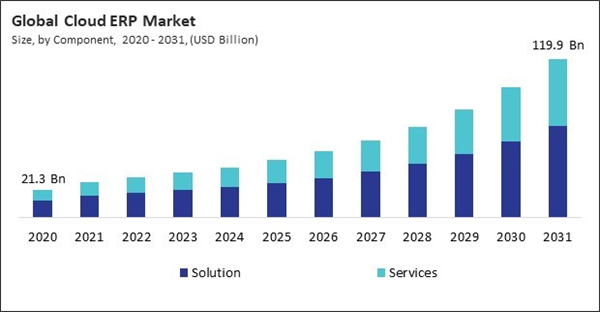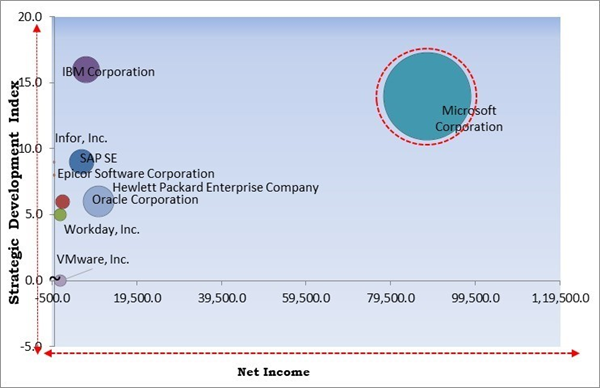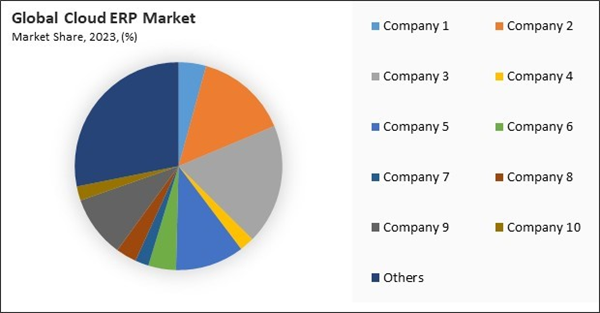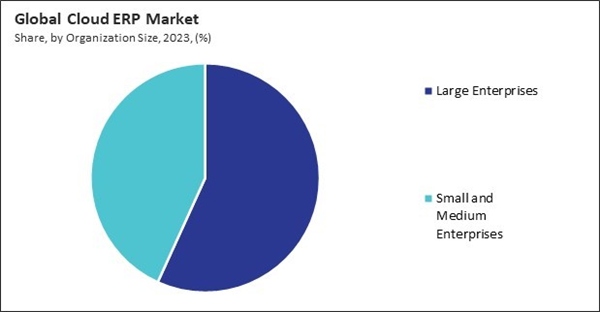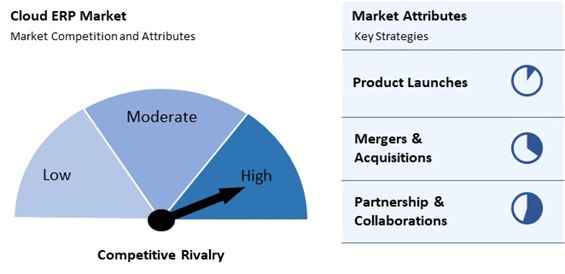The Global Cloud ERP Market size is expected to reach $119.9 billion by 2031, rising at a market growth of 17.8% CAGR during the forecast period.
Cloud ERP solutions that focus on human resources provide functionalities such as recruitment, onboarding, performance management, payroll processing, and employee self-service portals. Businesses can leverage these capabilities to enhance employee engagement, streamline HR processes, and improve workforce productivity. Therefore, in 2023, the human resource segment attained 17% revenue share in the market. This segment’s growth is driven by the increasing need for organizations to manage their workforce effectively in a dynamic business environment. The rise of remote work and the need for flexible HR solutions have further fuelled the demand for cloud ERP systems tailored to human resource management.
The major strategies followed by the market participants are Partnerships as the key developmental strategy to keep pace with the changing demands of end users. For instance, In January, 2024, IBM Corporation partnered with SAP to develop AI solutions for the consumer packaged goods and retail industries, enhancing supply chain, finance, and sales operations. Additionally, In October, 2023, IBM Corporation and KPMG US have expanded their partnership to implement SAP S/4HANA cloud-based ERP solutions for the energy and utilities sector, aiming to optimize business processes, enhance automation, and improve performance through industry-specific expertise and technology integration.
Automating business processes allows companies to concentrate on their core competencies rather than administrative tasks. This strategic focus leads to improved performance and enables organizations to allocate resources to innovation and growth initiatives. Cloud ERP solutions often include built-in compliance features that help businesses adhere to industry regulations. Automation aids in maintaining accurate records and reporting, reducing compliance risks. Additionally, advanced security measures protect sensitive information from data breaches. Hence, an increased focus on business process automation and operational efficiency drives the market's growth.
The leading players in the market are competing with diverse innovative offerings to remain competitive in the market. The above illustration shows the percentage of revenue shared by some of the leading companies in the market. The leading players of the market are adopting various strategies in order to cater demand coming from the different industries. The key developmental strategies in the market are Product Launches and Product Expansions.
The Cloud ERP Market is highly competitive, fueled by the growing demand for flexible and scalable enterprise resource planning solutions. Providers are competing to offer cloud-based platforms that streamline business processes, improve real-time data access, and support remote workforces. As more businesses transition from on-premise to cloud ERP systems, the competition intensifies around features such as integration capabilities, security, and customization options. Continuous innovation in AI, analytics, and automation is also a key focus, as companies aim to deliver more efficient and intelligent ERP solutions.
Cloud ERP solutions that focus on human resources provide functionalities such as recruitment, onboarding, performance management, payroll processing, and employee self-service portals. Businesses can leverage these capabilities to enhance employee engagement, streamline HR processes, and improve workforce productivity. Therefore, in 2023, the human resource segment attained 17% revenue share in the market. This segment’s growth is driven by the increasing need for organizations to manage their workforce effectively in a dynamic business environment. The rise of remote work and the need for flexible HR solutions have further fuelled the demand for cloud ERP systems tailored to human resource management.
The major strategies followed by the market participants are Partnerships as the key developmental strategy to keep pace with the changing demands of end users. For instance, In January, 2024, IBM Corporation partnered with SAP to develop AI solutions for the consumer packaged goods and retail industries, enhancing supply chain, finance, and sales operations. Additionally, In October, 2023, IBM Corporation and KPMG US have expanded their partnership to implement SAP S/4HANA cloud-based ERP solutions for the energy and utilities sector, aiming to optimize business processes, enhance automation, and improve performance through industry-specific expertise and technology integration.
Cardinal Matrix - Market Competition Analysis
Based on the Analysis presented in the Cardinal matrix; Microsoft Corporation is the forerunners in the Cloud ERP Market. In April, 2024, Microsoft Corporation and The Coca-Cola Company announced a five-year partnership to enhance cloud and generative AI initiatives. The collaboration aims to drive innovation and boost productivity, supporting Coca-Cola's digital transformation across its global operations and improving overall efficiency. Companies such as IBM Corporation, SAP SE and Infor, Inc. are some of the key innovators in Cloud ERP Market.Market Growth Factors
The push for digital transformation encourages organizations to innovate continually. Cloud ERP systems facilitate this innovation by providing the necessary tools and frameworks to develop new products and services, improving overall business performance. As industries undergo digital transformation, businesses must adopt advanced technologies to remain competitive. Cloud ERP solutions help organizations keep pace with industry trends and customer expectations, ensuring they can compete effectively in their respective markets. In conclusion, the rising demand for digital transformation initiatives across various industries drives the market's growth.Automating business processes allows companies to concentrate on their core competencies rather than administrative tasks. This strategic focus leads to improved performance and enables organizations to allocate resources to innovation and growth initiatives. Cloud ERP solutions often include built-in compliance features that help businesses adhere to industry regulations. Automation aids in maintaining accurate records and reporting, reducing compliance risks. Additionally, advanced security measures protect sensitive information from data breaches. Hence, an increased focus on business process automation and operational efficiency drives the market's growth.
Market Restraining Factors
High initial implementation costs and ongoing fees can strain an organization’s cash flow, particularly for smaller companies. Limited budgets may force businesses to delay or forgo adopting a Cloud ERP system, hindering their competitiveness and operational efficiency. Companies may need to prioritize other critical investments over ERP systems, especially in uncertain economic conditions. This hesitation can further delay the transition to cloud-based solutions, limiting the market’s growth potential. Therefore, high initial implementation costs and ongoing subscription fees hamper the market's growth.The leading players in the market are competing with diverse innovative offerings to remain competitive in the market. The above illustration shows the percentage of revenue shared by some of the leading companies in the market. The leading players of the market are adopting various strategies in order to cater demand coming from the different industries. The key developmental strategies in the market are Product Launches and Product Expansions.
Driving and Restraining Factors
Drivers
- Growing Importance of Real-Time Data and Analytics for Decision-Making
- Increased Focus on Business Process Automation and Operational Efficiency
- Rising Demand for Digital Transformation Initiatives Across Various Industries
Restraints
- High Initial Implementation Costs and Ongoing Subscription Fees
- Concerns Regarding Data Security and Privacy in Cloud-Based Solutions
Opportunities
- Growth Of Mobile and Remote Workforce Demands Efficient Cloud Erp Solutions
- Evolution of Subscription-Based Pricing Models to Improve Accessibility
Challenges
- Integration Challenges with Existing Legacy Systems and Processes
- Complexity of Vendor Selection and Due Diligence Processes
Component Outlook
Based on component type, the market is divided into solutions and services. The solution segment garnered 61% revenue share in the market in 2023. This segment includes a comprehensive array of software offerings that provide various ERP functionalities such as financial management, supply chain management, human resources, and customer relationship management. The high adoption rate of these solutions by enterprises seeking to streamline their operations and enhance overall efficiency has significantly contributed to this segment’s dominant market position.Services Outlook
The services segment is further subdivided into professional and managed. In 2023, the managed segment attained 55% revenue share in the market. Managed services involve outsourcing the management of ERP systems to third-party providers, who take on responsibilities such as monitoring, performance optimization, security management, and routine maintenance. This allows businesses to focus on their core activities while ensuring their ERP systems are managed by experts, leading to increased operational efficiency and cost savings.Function Outlook
On the basis of function, the market is segmented into operations, marketing, finance, human resource, and sales. The operations segment held 26% revenue share in the market in 2023. This segment encompasses various vital functions for maintaining efficient and effective business operations, including project management, production planning, and quality control. Cloud ERP solutions focusing on operations allow organizations to automate workflows, monitor performance metrics, and optimize resource allocation.Organization Size Outlook
Based on organization size, the market is categorized into small and medium enterprises and large enterprises. The small and medium enterprises segment witnessed 43% revenue share in the market in 2023. This growth reflects the increasing recognition among SMEs of adopting cloud ERP solutions to enhance operational efficiency and competitiveness. As these enterprises seek cost-effective and scalable solutions, cloud ERP systems offer the flexibility and accessibility required for their specific needs.Vertical Outlook
By vertical, the market is divided into BFSI, manufacturing, government, aerospace & defense, education, telecom & IT, healthcare and life sciences, retail, and others. The BFSI segment procured 21% revenue share in the market in 2023. The BFSI sector has been at the forefront of digital transformation, leveraging cloud technologies to enhance operational efficiency, customer service, and data management. Cloud ERP systems facilitate seamless integration of various business processes, enabling organizations to respond quickly to market changes and customer demands.Deployment Type Outlook
Based on deployment type, the market is divided into public, private, and hybrid. The public segment attained 56% revenue share in the market in 2023. The primary appeal of public cloud ERP systems lies in their cost-effectiveness and scalability. By leveraging shared infrastructure, businesses can reduce their IT expenses while gaining access to advanced functionalities without significant upfront investments in hardware and software. Public cloud ERP solutions also facilitate rapid deployment and ease of use, making them an attractive option for companies looking to streamline their operations quickly.Market Competition and Attributes
The Cloud ERP Market is highly competitive, fueled by the growing demand for flexible and scalable enterprise resource planning solutions. Providers are competing to offer cloud-based platforms that streamline business processes, improve real-time data access, and support remote workforces. As more businesses transition from on-premise to cloud ERP systems, the competition intensifies around features such as integration capabilities, security, and customization options. Continuous innovation in AI, analytics, and automation is also a key focus, as companies aim to deliver more efficient and intelligent ERP solutions.
By Regional Analysis
Region-wise, the market is analyzed across North America, Europe, Asia Pacific, and LAMEA. The North America region witnessed 36% revenue share in the market in 2023. The dominance of North America can be attributed to the presence of numerous major cloud ERP providers, a robust technology infrastructure, and a high concentration of businesses across various sectors, including finance, healthcare, manufacturing, and retail. Organizations in this region increasingly recognize the strategic advantages of cloud ERP systems, such as enhanced scalability, real-time analytics, and improved operational efficiencies.Recent Strategies Deployed in the Market
- Sep-2024: IBM Corporation acquired Accelalpha, a global Oracle consultancy, to enhance its expertise in Oracle Cloud ERP, SCM, and related services, thereby strengthening its ability to assist clients in modernizing core business operations through Oracle Cloud Applications and AI technologies.
- Aug-2024: Hewlett Packard Enterprise (HPE) acquired Morpheus Data to enhance its hybrid cloud management capabilities. This acquisition will improve application provisioning, orchestration, and FinOps management within HPE GreenLake, further supporting efficient enterprise resource planning (ERP) solutions in multi-cloud environments.
- Aug-2024: Workday, Inc. is collaborating with Salesforce to develop a common data platform for integrating AI applications, enhancing efficiencies for joint customers. However, analysts believe this partnership will not disrupt the existing ERP market dominated by SAP and Oracle.
- Jul-2024: Infor, Inc. has acquired Albanero and Acumen to enhance its industry-focused cloud ERP solutions. These acquisitions will improve data migration and management capabilities, enabling customers to leverage their industry-specific data for greater value and profitable growth in cloud environments.
- Jun-2024: Oracle and Google Cloud have announced a partnership to integrate Oracle Cloud Infrastructure with Google Cloud, enabling customers to accelerate application migrations and management. This collaboration will enhance enterprise resource planning capabilities and streamline workflows across multiple cloud environments globally.
List of Key Companies Profiled
- IBM Corporation
- Microsoft Corporation
- SAP SE
- Hewlett Packard Enterprise Company
- Oracle Corporation
- Epicor Software Corporation
- VMware, Inc. (Broadcom Inc.)
- Infor, Inc. (Koch Industries)
- Workday, Inc.
- SYSPRO (Advent International)
Market Report Segmentation
By Component
- Solution
- Services
- Managed
- Professional
By Organization Size
- Large Enterprises
- Small and Medium Enterprises
By Deployment Type
- Hybrid
- Public
- Private
By Function
- Finance
- Operations
- Human Resource
- Marketing
- Sales
By Vertical
- BFSI
- Manufacturing
- Telecom & IT
- Healthcare and Life Sciences
- Government
- Retail
- Aerospace & Defense
- Education
- Other Verticals
By Geography
- North America
- US
- Canada
- Mexico
- Rest of North America
- Europe
- Germany
- UK
- France
- Russia
- Spain
- Italy
- Rest of Europe
- Asia Pacific
- China
- Japan
- India
- South Korea
- Singapore
- Malaysia
- Rest of Asia Pacific
- LAMEA
- Brazil
- Argentina
- UAE
- Saudi Arabia
- South Africa
- Nigeria
- Rest of LAMEA
Table of Contents
Chapter 1. Market Scope & Methodology
Chapter 2. Market at a Glance
Chapter 3. Market Overview
Chapter 4. Competition Analysis - Global
Chapter 5. Global Cloud ERP Market by Component
Chapter 6. Global Cloud ERP Market by Organization Size
Chapter 7. Global Cloud ERP Market by Deployment Type
Chapter 8. Global Cloud ERP Market by Function
Chapter 9. Global Cloud ERP Market by Vertical
Chapter 10. Global Cloud ERP Market by Region
Chapter 11. Company Profiles
Companies Mentioned
- IBM Corporation
- Microsoft Corporation
- SAP SE
- Hewlett Packard Enterprise Company
- Oracle Corporation
- Epicor Software Corporation
- VMware, Inc. (Broadcom Inc.)
- Infor, Inc. (Koch Industries)
- Workday, Inc.
- SYSPRO (Advent International)
Methodology

LOADING...



